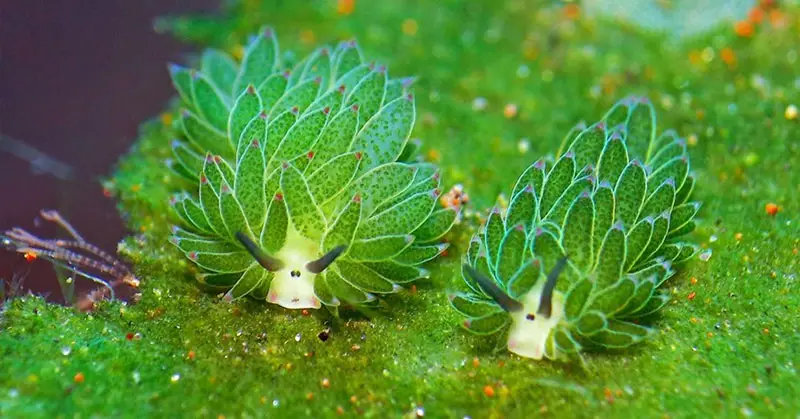These little animals are like something out of a Dr. Seuss book. They are called leaf sheep and they look like a cartoon version of a farm animal, act like plants, and their habitat is the sea floor. Strangest of all, these leaf sheep use photosynthesis to get energy, one of the very few animals to do so.
Sea Slug that Look Like a Sheep and a Cluster of Leaves
Costasiella kuroshimae (more easily known as ‘leaf sheep’) nourish themselves with a process called kleptoplasty. They eat algae, suck out its chloroplasts, and absorb them into their bodies. Kleptoplasty can only be done by a single-celled organism. Basically, leaf sheep are solar-powered sea plant slugs with the face of a farm animal. These sea slugs have no connection to actual sheep, besides for their cute little faces. [1]
These little creatures are only about 5 mm long and reside in the shallow waters around Indonesia, the Philippines, and Japan. Their heads are white with beady little eyes, and their bodies look like a cluster of leaves. Their “plumage” can come in any different colors and shapes, just like with real plants. [2]
The head of the slug could have a wide brownish band, brown patches, red spots, blue patches, and their rhinophores could have a mix of white and black. [3]
How Leaf Sheep Use Photosynthesis
This is one of the extremely few sea creatures that optimize photosynthesis, which is what most plants use to make their own food by turning light energy into nourishment. Chloroplasts are one of the plant cell organelles that aid energy storage and the synthesis of proteins, oils, and starches. This makes chloroplasts one of the most important characteristics of plants to conduct photosynthesis. Chloroplasts can be found in all green structures in all greenery, like stems and unripe fruits, but most photosynthesis happens in the leaves. [4]
When these slugs use kleptoplasty, they basically “steal” undigested chloroplasts from food, like algae in this case. Then the chloroplasts continue to function and give energy to the leaf sheep. To be clear, leaf sheep cannot photosynthesize on their own; they simply absorb the organelles that do the photosynthesis for them and use the provided energy. This allows the slug to survive without eating for periods of time.
Other Animals that Use Photosynthesis
The Pea Aphid
The pea aphid is a tiny white, almost translucent-looking, insect that feeds on plants. It can produce pigments found in chloroplasts and chromoplasts, which gives them a reddish color and perhaps allows photosynthesis. More research in needed to confirm this, and discover what these insects would gain by making energy from sunlight. [5]
The Spotted Salamander
Spotted salamanders are little black reptiles with yellow spots, and they live in symbiotic relationships with algae. Their embryos are in clear-colored eggs that are laid on underwater plants in shallow areas so that they can have access to sunlight. Algae found in the embryos helps provide energy for growth and development from the sun. This extra source of energy increases the eggs’ chance of survival.
These salamanders are the only species among all vertebrae that directly benefit from photosynthesis. Usually, highly developed organisms like other salamanders prevent this sort of symbiotic behavior. [6]
The Green Sea Slug
Leaf sheep aren’t the only sea slugs that use photosynthesis. The green sea slug is a beautiful creature that resembles a wide, bright leaf. It eats algae and consumes chloroplasts and some genes from it. This allows them to gain energy from the sun through photosynthesis using kleptoplasty.
“We collect them and we keep them in aquaria for months,” said Sidney Pierce, a biologist at the University of South Florida in Tampa. “As long as we shine a light on them for 12 hours a day, they can survive [without food].” [7]
These incredible creatures show the diversity of flora and fauna, and how fascinating it could be when they cross into each other. As researchers dive into this process of gaining energy, many speculate if photosynthesis will become possible for humans one day. [8]
Keep Reading: Woman Shares Photos of an Amazing Flower-Like Bug That Looks like A Work of Art
Sources
- “Sea Sheep? This Adorable Sea Slug Eats So Much Algae It Can Photosynthesize.” BoredPanda. Dovas
- “Costasiella sp. 3.” Sea Slug Forum April 2, 2003.
- “Chloroplasts.” Molecular Expressions. Michael W. Davidson. November 13, 2015
- “These Cute Sea Slugs Are The Sheep Of The Sea.” IFL Science. Lynn Wu.
- “Pea Aphids Use Photosynthesis To Produce Energy Like Plants, Insect Study Shows.” Huff Post. Megan Gannon. August, 22, 2012
- “Incredible Creatures that Use Photosynthesis For Energy.” Futurism. Megan Gannon. March 9, 2014
- “Surprising Sea Slug Is Half-plant, Half-animal.” Live Science. Clara Moskowitz. January 12, 2010
- “Will We Ever… Photosynthesise Like Plants?” National Geographic. Ed Yong. September 18, 2012

